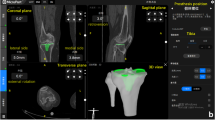Abstract
Our research team developed a new, heel support-based static and vibrating complementary treatment method for the prevention of flexion contractures often arising after total knee arthroplasty. We examined the efficiency of the method performing a randomized clinical trial with 144 patients undergoing total knee replacement. Seventy-nine patients were treated for 1 week with a generally used continuous passive motion (CPM) device complemented with our new method, which was based on the application of a static and an alternating heel support. The 65 patients in the control group were treated with only a CPM device as in usual clinical practice. The femoro-tibial angle was measured immediately following surgery, and after 1 week of treatment. At the end of the 1 week treatment, the target extension angle (0° ± 5°) was achieved by significantly more patients with the new combined method. This way the elevated heel rest and the vibrating device proved to be a good adjunct treatment along with the CPM used in routine clinical practice in the first place for the prevention of flexion contractures.






Similar content being viewed by others
References
Aderinto J, Brenkel IJ, Chan P (2005) Natural history of fixed extension deformity following total knee replacement: a prospective five-year study. J Bone Joint Surg Br 87(7):934–936. doi:10.1302/0301-620X.87B7.15586
Quah C, Swamy G, Lewis J, Kendrew J, Badhe N (2012) Fixed flexion deformity following total knee arthroplasty. A prospective study of the natural history. Knee 19(5):519–521. doi:10.1016/j.knee.2011.09.003
Gáspár L, Farkas C, Szepesi K, Csernátony Z (1997) Therapeutic value of continuous passive motion after anterior cruciate replacement. Acta Chir Hung 36(1–4):104–105
Rodriguez-Merchan EC (2011) Instability following total knee arthroplasty. HSS J 7(3):273–278
Draghi F, Danesino GM, Coscia D, Precerutti M, Pagani C (2008) Overload syndromes of the knee in adolescents: sonographic findings. J Ultrasound 11(4):151–157
Seyler TM, Marker DR, Bhave A, Plate JF, Marulanda GA, Bonutti PM, Delanois RE, Mont MA (2007) Functional problems and arthrofibrosis following total knee arthroplasty. J Bone Joint Surg Am 89(Suppl 3):59–69. doi:10.2106/JBJS.G.00457
Salter RB (1989) The biologic concept of continuous passive motion of synovial joints. The first 18 years of basic research and its clinical application. Clin Orthop Relat Res 242:12–25
Ververeli PA, Sutton DC, Hearn SL, Booth RE Jr, Hozack WJ, Rothman RR (1995) Continuous passive motion after total knee arthroplasty. Analysis of cost and benefits. Clin Orthop Relat Res 321:208–215
Basso DM, Knapp L (1987) Comparison of two continuous passive motion protocols for patients with total knee implants. Phys Ther 67(3):360–363
Szabó J, Bakó K, Manó S, Csernátony Z (2012) A fájdalom ingerület-vezetés spinális gátlásának elvét felhasználó térdmozgató készülék bemutatása. Biomech Hung 5(1):39–43
Bennett D, Hanratty B, Thompson N, Beverland D (2009) Measurement of knee joint motion using digital imaging. Int Orthop 33(6):1627–1631
Manó S, Pálinkás J, Kiss L, Csernátony Z (2012) The influence of lateral knee X-ray positioning on the accuracy of full extension level measurements: an in vitro study. Eur J Orthop Surg Traumatol 22(3):245–250
Austin MS, Ghanem E, Joshi A, Trappler R, Parvizi J, Hozack WJ (2008) The assessment of intraoperative prosthetic knee range of motion using two methods. J Arthroplasty 23(4):515–521
Boone DC, Azen SP, Lin CM, Spence C, Baron C, Lee L (1978) Reliability of goniometric measurements. Phys Ther 58(11):1355–1360
Acknowledgments
The authors wish to thank Veronika Kósa and her colleagues who gave their time to participate in the study.
Conflict of interest
None.
Author information
Authors and Affiliations
Corresponding author
Rights and permissions
About this article
Cite this article
Manó, S., Pálinkás, J., Szabó, J. et al. Application of a vibrating device for the prevention of flexion contracture after total knee arthroplasty. Eur J Orthop Surg Traumatol 25, 167–172 (2015). https://doi.org/10.1007/s00590-014-1466-4
Received:
Accepted:
Published:
Issue Date:
DOI: https://doi.org/10.1007/s00590-014-1466-4




